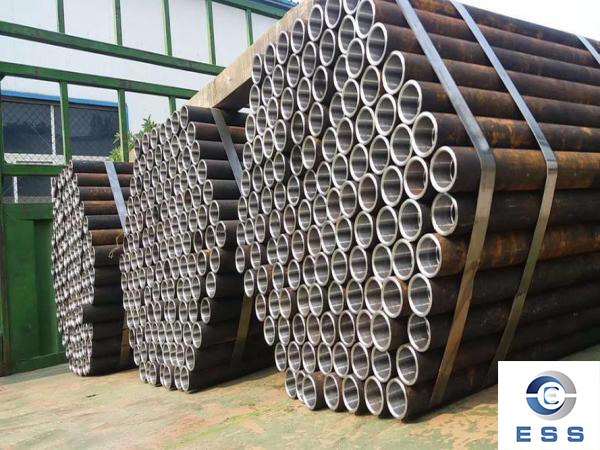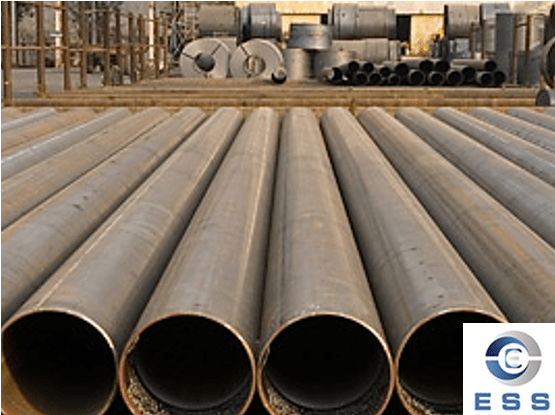White deposits on the surface of the seamless hydraulic tubes indicate that the protective coating has corroded, but the strength of the steel pipe has not yet been damaged. Red deposits (rust) on the other hand indicate that the steel pipe itself has corroded and may have lost strength.

High-pressure line pipes are often used in corrosive environments, which will eventually weaken the line. Without any protection, their full functionality cannot be guaranteed. Seamless cold-drawn steel pipes produced by Eastern Steel Manufacturing are widely used as pressure lines in hydraulic or pneumatic systems and meet the DIN EN 10305-4 standard, which stipulates technical specifications.
These pipes are used in applications such as construction, agricultural and mining equipment exposed to harsh environments. Without surface protection, the steel will immediately react with the environment and corrode electrochemically.
A common way to protect the pipe is to coat the surface with a layer of zinc. This layer can be produced by a galvanizing process and common thicknesses are about 8 to 12 μm or 12 to 15 μm. The zinc coating of hydraulic tubes for corrosion protection serves two purposes - it protects the steel surface from direct contact with the surrounding environment and acts as a sacrificial anode, which means that it corrodes before the steel does. However, it will eventually corrode enough to expose the base material to the surrounding environment. Therefore, the zinc layer itself is usually protected by a second layer. Typically, there are two common layers: a layer containing Cr(VI) called the chromate layer, which usually has a yellow or olive green appearance, and a layer without Cr(VI) called the passivation layer, which usually has a silver, blue or black appearance. These layers add about 0.5 μm to the thickness and provide an additional barrier. Sometimes a third sealing layer is also applied.
But these protective layers are not forever. Any kind of mechanical strain, especially bending, can damage the outer chromate layer or the passivation layer over time. This can expose spots or parts of the zinc layer to the environment, and under certain conditions, the zinc can corrode and form white rust, which is a white, powdery, bulky deposit. While white corrosion is an early sign that the protective system has been compromised, the tube itself has not yet been affected. Once the zinc layer is exhausted - again, even if it is only in a single spot or small area - the base material of the tube is exposed and the steel can react with the surrounding oxygen and water. The reaction product is rust, which is a clear indication that the substrate has been compromised and the full functionality of the pressure line can no longer be guaranteed.
In order to compare the performance of various protection systems, a salt spray test (DIN EN ISO 9227) can be performed, exposing the sample to standard salt water, heating environment, and measuring the time when white or red rust first appears. Although the results cannot be converted into the time a specific coating will protect the pipeline under different environments, it does provide a convenient method of comparison.
Anti-corrosion method
1.3PE anti-corrosion process: This is a common anti-corrosion process for seamless steel pipes, including a three-layer structure of epoxy powder layer, adhesive layer and polyethylene layer to form an excellent anti-corrosion layer.
2. Epoxy coal tar anti-corrosion: Epoxy coal tar paint is used to wrap glass cloth, and topcoat is applied on the outside. Anti-corrosion treatment is carried out through steps such as rust removal, primer, topcoat and glass cloth wrapping.
3. Epoxy resin anti-corrosion: Epoxy resin material is used for anti-corrosion, which is suitable for the anti-corrosion of contact equipment such as food and drinking water. It has the characteristics of non-toxicity, high strength, hydrolysis resistance and corrosion resistance.
4.IPN8710 anticorrosion: This is a liquid epoxy coating used for the inner wall of the pipeline to provide anticorrosion protection, but its adhesion and anticorrosion performance may be slightly inferior to that of hot-melt epoxy powder coating.
5. Cement mortar anticorrosion process: A cement mortar protective layer is formed on the inner wall of the pipeline to prevent corrosion.
6. Fusion epoxy powder anticorrosion: A heavy anticorrosion coating formed at high temperature, which has the advantages of easy operation, no pollution, good impact resistance and bending resistance.
7.2PE/3PE anticorrosion: Similar to 3PE anticorrosion, but the number of layers is different. 2PE anticorrosion has only two layers, while 3PE anticorrosion has three layers, providing better anticorrosion effect.
8. Single-layer PE anticorrosion: A polyethylene coating is formed on the outer wall of the steel pipe using a spray coating process, which is used for water-coated composite steel pipes.
9. Chemical treatment: Injecting preservatives or corrosion inhibitors into the inside of the pipeline, suitable for pipelines that transport corrosive media.
10. Coating treatment: Rust-proof paint or plastic lining is applied to the inner and outer surfaces of the pipe, suitable for conveying non-corrosive media.
Two types of chromium
There is a clear and critical difference between the chromate layer and the passivation layer. The chromate layer contains toxic hexavalent chromium Cr(VI), while the passivation layer contains no or only a small amount of chromium. The passivation layer contains trivalent chromium Cr(III), which is non-toxic. Since July 2007, the European End-of-Life Vehicle Directive has come into effect, prohibiting the use of any toxic substances such as hexavalent chromium Cr(VI) as well as lead, mercury or cadmium in automobiles.













 Eastern Steel Manufacturing Co.,Ltd not only improve product production and sales services, but also provide additional value-added services. As long as you need, we can complete your specific needs together.
Eastern Steel Manufacturing Co.,Ltd not only improve product production and sales services, but also provide additional value-added services. As long as you need, we can complete your specific needs together.










